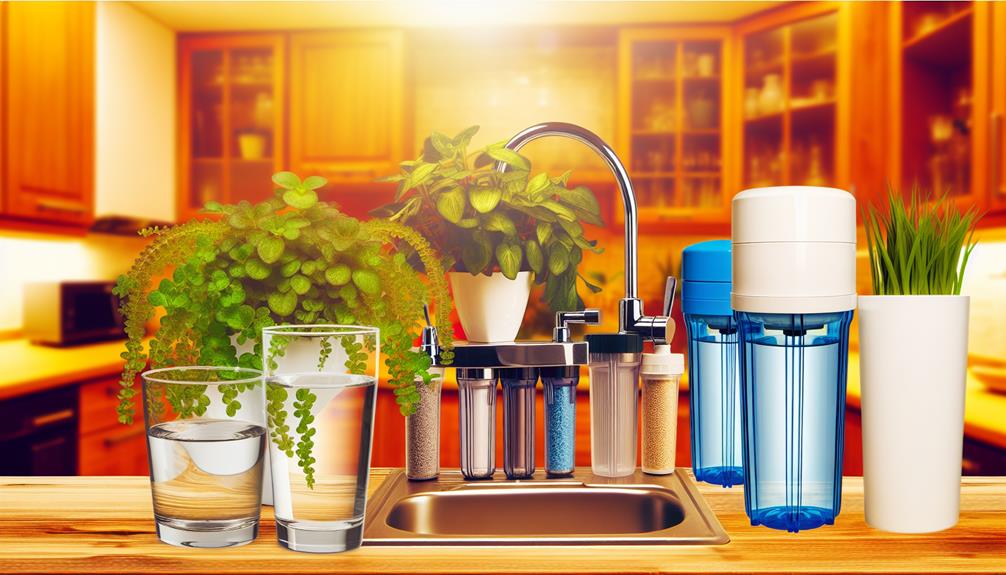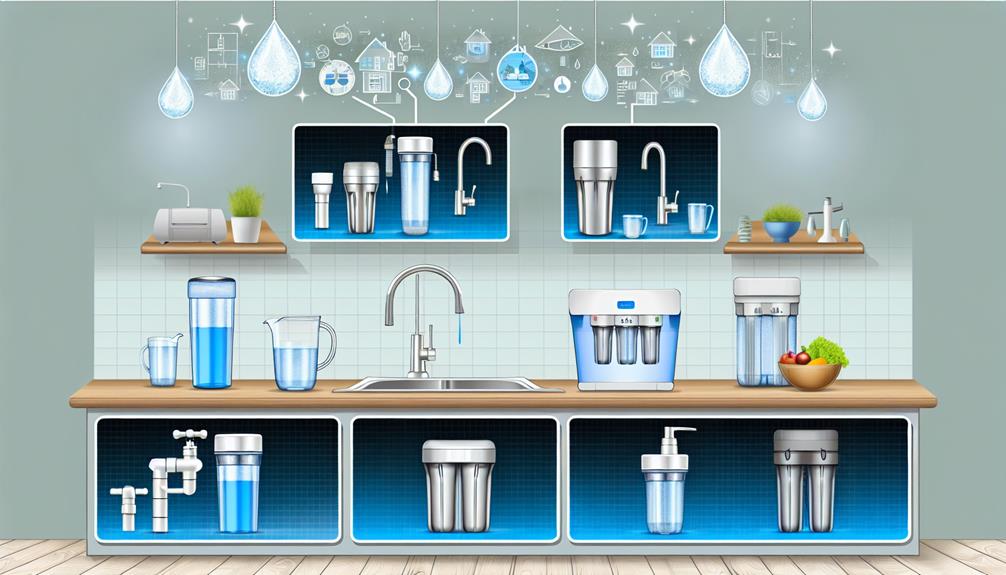Filters forge the future of freshwater, and you're at the forefront of this fluid transition. As you consider the environmental footprint of conventional water purification, you recognize that sustainable solutions aren't just preferable—they're imperative.
Green water filtration offers a path to preserve precious resources while providing potable water. You're about to explore the latest in biodegradable filter materials, solar-powered systems, and plant-based techniques, each promising to purify without the penalty of pollution.
As you navigate the nuances of low-energy desalination and rainwater harvesting, consider how these innovations could integrate seamlessly into your daily life, potentially revolutionizing your water consumption habits.
The question that lingers is not if, but how quickly these green filtration methods will become the new norm in a world thirsty for sustainability.
Biodegradable Filter Materials
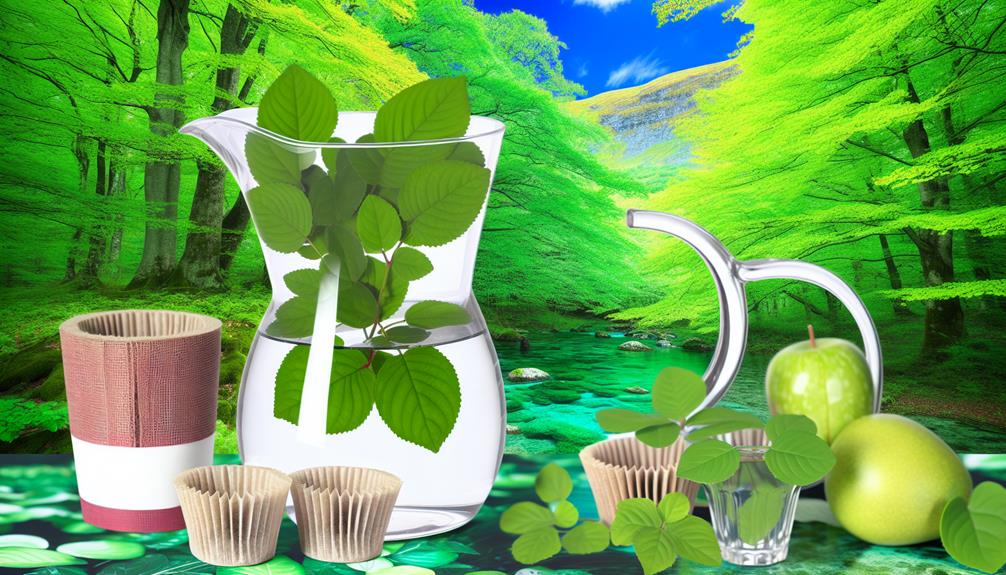
While traditional water filtration materials pose environmental risks due to their non-biodegradable nature, recent advancements have led to the development of biodegradable filter materials that offer a sustainable alternative without compromising filtration efficacy.
Innovations in this sector are particularly focused on the integration of algae assimilation and mushroom media into the design of filtration systems.
Algae, a naturally occurring aquatic organism, has shown remarkable promise in water purification. Its innate ability to absorb contaminants and nutrients from water bodies is harnessed in biodegradable filters to remove harmful substances effectively. The assimilation process involves cultivating specific algae strains that excel at sequestering pollutants, thereby producing cleaner water while also reducing the filter's environmental footprint.
Mushroom media, derived from the mycelium of fungi, is another breakthrough material. It's not only biodegradable but also has a robust structure, making it an excellent candidate for filtering out larger particulates. The porous nature of mycelium allows water to pass through while trapping sediments and microbes. These attributes ensure that the mushroom-based filters perform on par with conventional options, all the while promoting a closed-loop system that aligns with principles of sustainability.
You, as a stakeholder in eco-friendly practices, can appreciate the technical finesse these biodegradable materials bring to water filtration, offering a green solution that doesn't sacrifice performance for environmental responsibility.
Solar-Powered Purification Systems
Building on the foundation of biodegradable materials, solar-powered purification systems harness renewable energy to further reduce the ecological impact of water treatment processes. You're tapping into the sun's ample power, not only cutting down on fossil fuel consumption but also significantly diminishing the carbon footprint associated with conventional water purification.
Imagine a system where:
- Photovoltaic panels capture sunlight, converting it into electricity with minimal loss of energy.
- UV-LED technology utilizes this clean electricity to eradicate pathogens, ensuring safe drinking water without chemical additives.
- Smart sensors manage the operation, optimizing energy use and efficiency even under varying sunlight conditions.
These components work in synergy, creating a robust solution for contamination reduction. The use of renewable energy in these systems exemplifies a commitment to sustainability, allowing for a closed-loop process that minimizes environmental strain.
You're at the forefront of water treatment, deploying systems that are resilient and adaptable to different environments. The technical expertise required to design and implement these solar-powered systems reflects a dedication to innovation and a meticulous approach to resource management.
Investing in such technology paves the way for a future where clean water and green energy go hand in hand.
Plant-Based Filtration Techniques
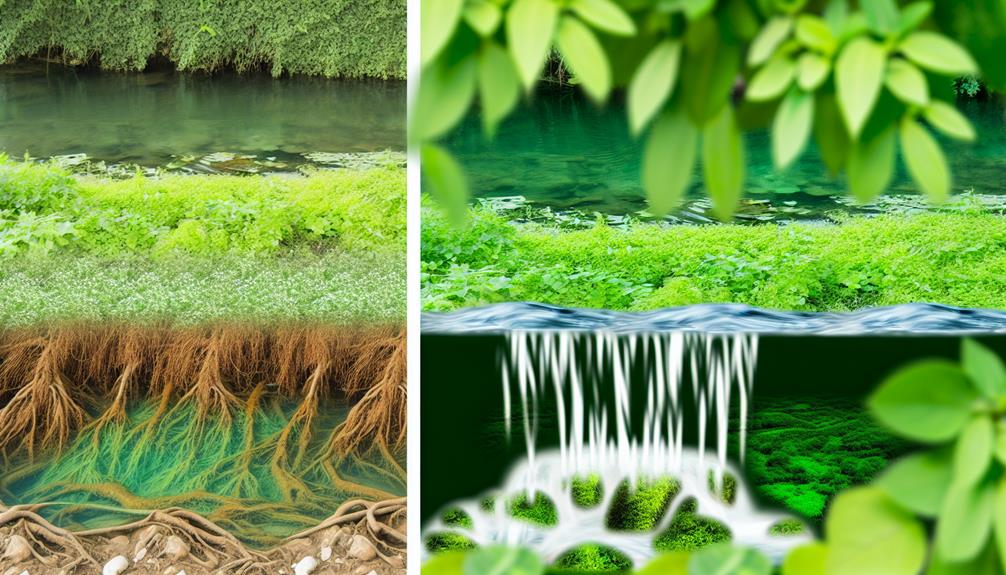
Harnessing the innate purification capabilities of plants, you can implement filtration systems that leverage natural processes to cleanse water with remarkable efficiency and sustainability. Plant-based filtration, also known as phytoremediation, utilizes certain species to absorb and metabolize pollutants from water bodies. This not only enhances phytoremediation efficiency but also contributes to a holistic approach such as aquatic permaculture, which integrates plant and aquatic life to create a self-sustaining ecosystem.
To understand the specifics, consider the table below:
| Plant Species | Pollutant Targeted | Usage Context |
|---|---|---|
| Cattails | Heavy Metals | Wetlands |
| Duckweed | Nutrients | Ponds |
| Water Hyacinths | Organic Compounds | Waterways |
| Reed Plants | Sediment | Constructed Wetlands |
These species excel in different areas of filtration. Cattails, for instance, are highly effective at absorbing heavy metals, while duckweed can remove excess nutrients that otherwise lead to eutrophication. Water hyacinths are known for their capacity to clear organic compounds, and reed plants can stabilize sediment, preventing it from clouding water bodies.
You'll find that incorporating these techniques isn't just about purifying water—it's about restoring natural balance and enhancing biodiversity. As you explore the depths of plant-based filtration, you'll be contributing to a greener future with each sustainable step you take.
Low-Energy Desalination Innovations
Continuing our exploration of sustainable water treatment methods, low-energy desalination innovations offer a promising avenue for converting saline water into fresh water with minimal environmental impact. These technological leaps are crucial in a world where freshwater scarcity is a growing concern. You'll find that recent advancements aren't only impressive but also pivotal for the future of water security.
Consider these innovations:
- Enhanced Electrodialysis Efficiency: This process uses an electric current to transfer salt ions through selective membranes. Modern enhancements have improved energy efficiency, reducing the carbon footprint of desalination plants.
- Solar-Powered Desalination: Solar energy, abundant and renewable, is harnessed to heat saline water, causing evaporation and subsequent condensation as potable water. This method sidesteps the high energy costs associated with conventional desalination.
- Nanofiltration Advancements: Nanofiltration membranes have become more sophisticated, enabling the removal of salts with lower pressure requirements. These membranes target specific ions, which allows for precise water hardness adjustments and lower energy consumption.
As you delve deeper into these technologies, you'll appreciate the nuanced interplay between sustainability and innovation. Electrodialysis efficiency and nanofiltration advancements stand out as keystones in the realm of low-energy desalination, ensuring that fresh water can be sustainably sourced from the sea.
Rainwater Harvesting Integration
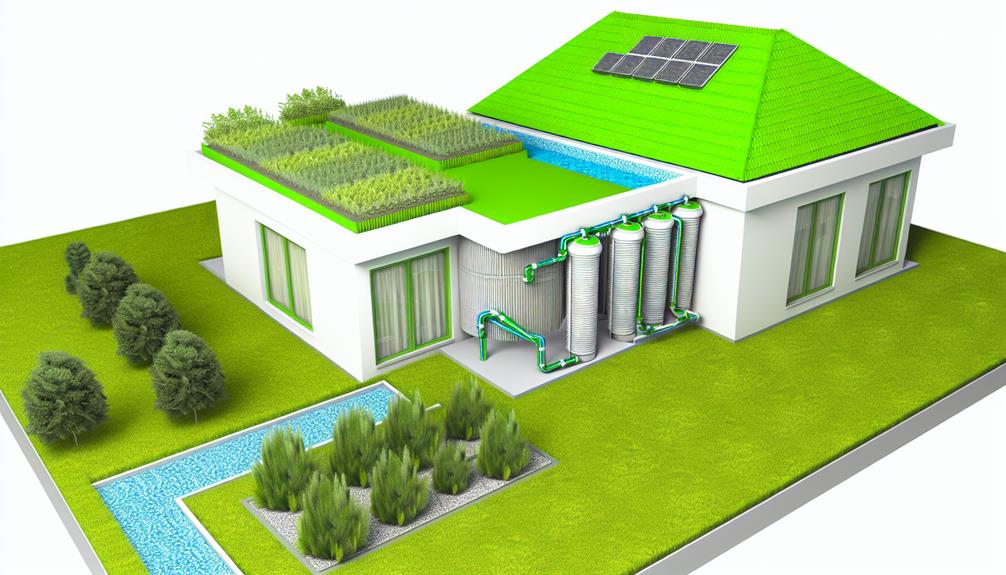
Integrating rainwater harvesting into urban and rural infrastructures presents a viable solution for augmenting water supplies while reducing dependency on traditional water sources. As you consider this approach, you're looking at a system that not only enhances water reclamation but also contributes to effective stormwater management.
By capturing precipitation directly, you alleviate the strain on municipal systems during peak downpours, mitigating flood risks and lessening the impact of runoff on local ecosystems.
Your focus on sustainability means selecting materials and designs that are durable, low-maintenance, and fit seamlessly within existing landscapes or architectural plans. You'll need to calculate catchment areas, storage capacities, and filtration requirements with precision to ensure a reliable supply of clean water.
It's essential to integrate first flush diverters and fine mesh filters to exclude debris and contaminants, thus safeguarding water quality.
Rainwater harvesting systems can be linked to irrigation, flushing toilets, or even potable systems after adequate treatment. This integration not only conserves precious groundwater and surface water resources but also reduces your carbon footprint by diminishing the energy needed for water transport and treatment.
You're not just installing a system; you're adapting a lifestyle that prioritizes resource efficiency and environmental stewardship.
Conclusion
You've explored the frontier of green water filtration, from biodegradable materials to plant-based techniques. Embracing solar-powered systems and low-energy desalination, you're reducing carbon footprints.
Integrating rainwater harvesting complements these sustainable solutions. Your commitment to eco-friendly innovation not only conserves resources but also paves the way for a cleaner, more sustainable future.
Continue championing these advancements; you're vital in the global shift towards environmentally-responsible water management.
